For pet owners who also cherish a well-manicured lawn, the challenge of establishing a new grassy area can be compounded by the presence of energetic dogs. Dogs can unintentionally harm fragile new grass by running, digging, or simply by doing their business on it, which can be especially damaging for freshly sown seeds that are yet to take root. Ensuring that a newly seeded lawn has the best chance to thrive means keeping dogs at a safe distance for a critical period of time during which the grass seeds germinate and the new grass plants begin to establish themselves.
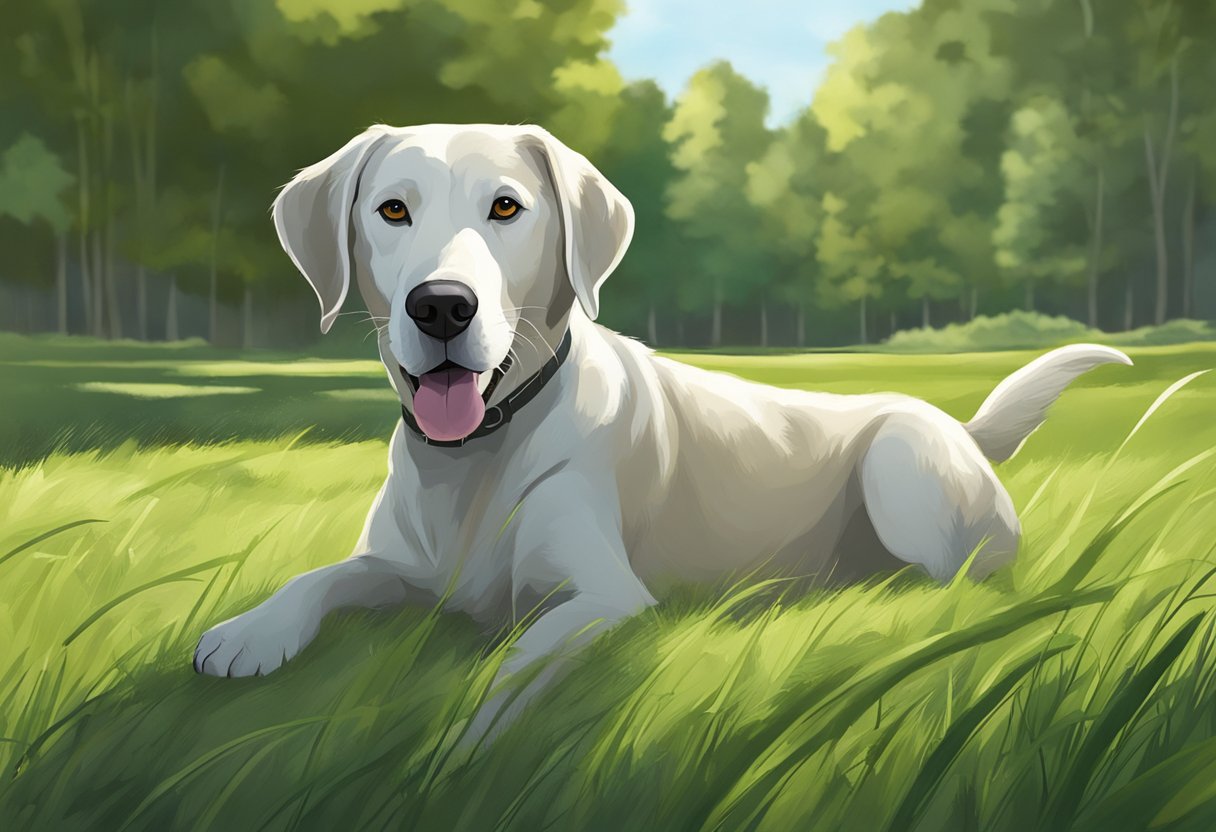
Knowing the right amount of time to restrict pets from accessing the area can be a balancing act. It’s important to give the new seedlings enough time to mature into a durable lawn that can withstand the wear and tear of a dog’s daily activities. This involves understanding how different grass varieties cope with the presence of pets and their specific growing times. Furthermore, considering the health risks that some grass seeds may pose to our furry companions, such as injuries from sharp seed husks, is also vital in maintaining the well-being of both the lawn and the pet.
Key Takeaways
- Dogs need to be kept away from newly seeded lawns to ensure proper grass growth.
- The duration of restriction varies depending on the grass type and the lawn’s environmental conditions.
- Pet safety and preventing grass seed injuries are essential considerations during lawn establishment.
Understanding Grass Seed and Your Lawn
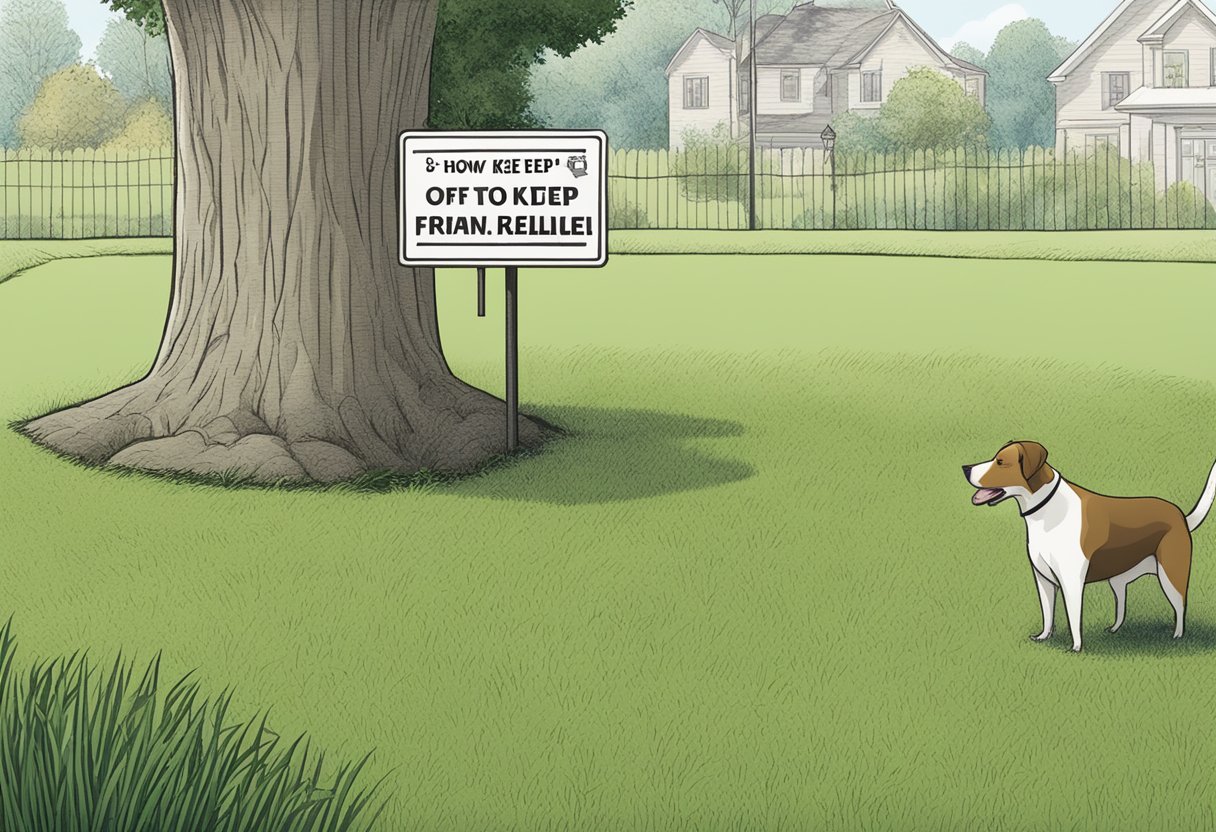
When planting grass seed to enhance or repair a lawn, understanding the growth cycle and the types of grass suitable for areas with pets is essential. Conducting a soil test can be a pivotal first step, ensuring soil conditions are optimal for seed germination and early growth.
Grass varieties such as Perennial Ryegrass, Tall Fescue, and Kentucky Bluegrass are often selected for cooler climates due to their resilience to pet damage. For warmer regions, the hardier Zoysia, Bermuda, or Bahia grass might be best suited for maintaining a lush lawn.
When planting grass seed, timing and preparation are key. One should:
- Remove debris and loosen soil.
- Apply fertilizer as indicated by the soil test.
- Evenly distribute the grass seed.
Caring for a newly seeded lawn involves keeping the area moist to aid germination and avoiding heavy foot traffic, especially from pets. Securing the area to prevent dogs from causing damage is recommended until the grass has established—typically around three to four weeks. Addressing bare spots promptly and choosing the right grass seed varieties for dog-hardy lawns can lead to a robust yard less susceptible to damage.
Remember, consistent and considerate lawn care after seeding ensures a healthier, more pet-friendly lawn over time.
Why Keeping Dogs Off Newly Seeded Areas Matters
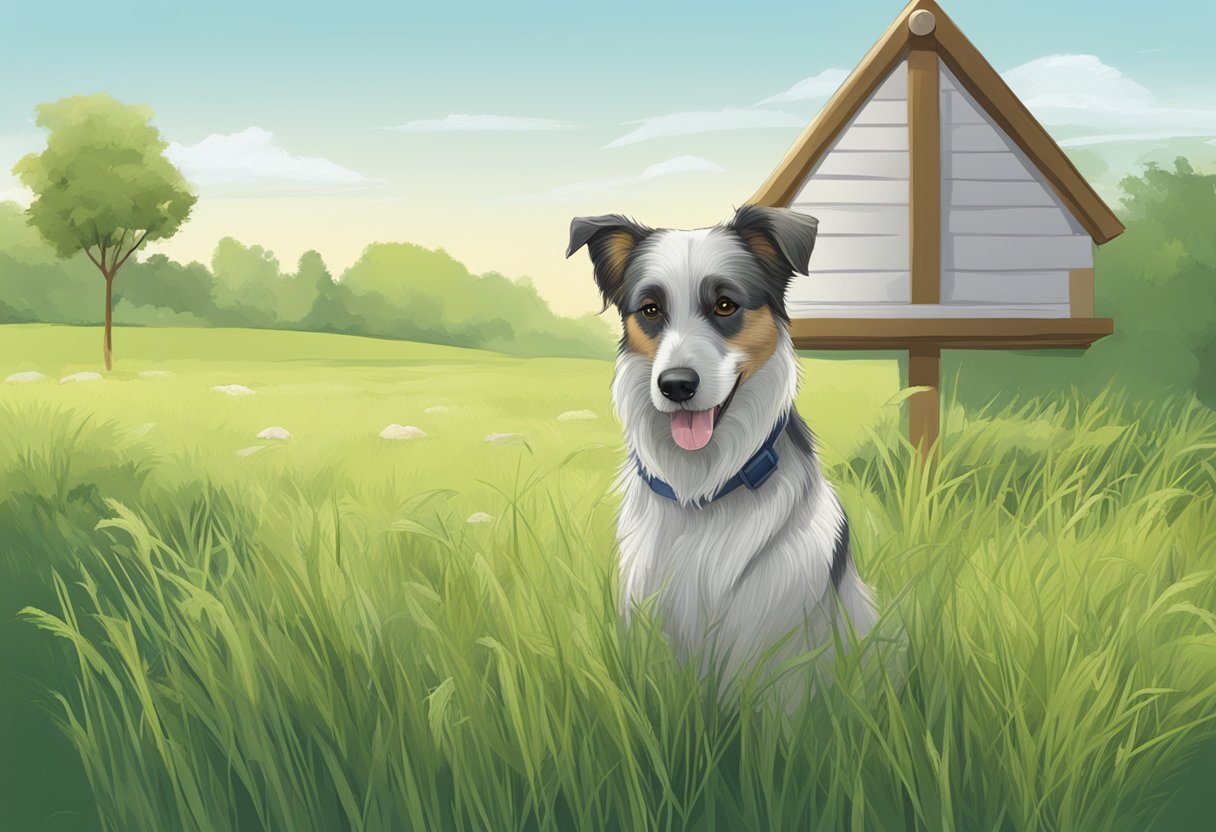
When introducing fresh grass seeds to a lawn, vigilance is essential in managing how dogs interact with these areas. Dogs, with their sharp paws and natural curiosity, pose a significant threat to the delicate seeding process. The paw pressure and foot traffic from a dog can dislodge or bury seeds too deeply, effectively preventing them from germinating properly.
Additionally, a dog’s fur can inadvertently collect and transfer seeds to other parts of the garden or home, reducing the density of the new growth where it’s intended. Fertilizers used in the seeding can also stick to a dog’s fur or paws, leading to safety concerns if the dog ingests these substances. Ingestion of chemical fertilizers can lead to an array of health problems, potentially requiring a visit to the vet for treatment of symptoms like irritation, vomiting, or even infection.
It’s not just the physical disruption of seeds that’s concerning. Dogs may feel inclined to eat the seeds, which can affect digestive health. Moreover, their natural behavior to dig and explore can uproot seeds and damage the young shoots that are attempting to establish.
To protect the investment in your lawn and the health of your pets, keeping your dog off the grass during the critical germination period is advised. Implementing barriers or creating designated play areas can mitigate risk and encourage the successful growth of a lush and healthy lawn. This cautious approach addresses safety concerns for both the new grass and the well-being of pets.
Identifying Safe Duration for Dogs on New Grass Seed
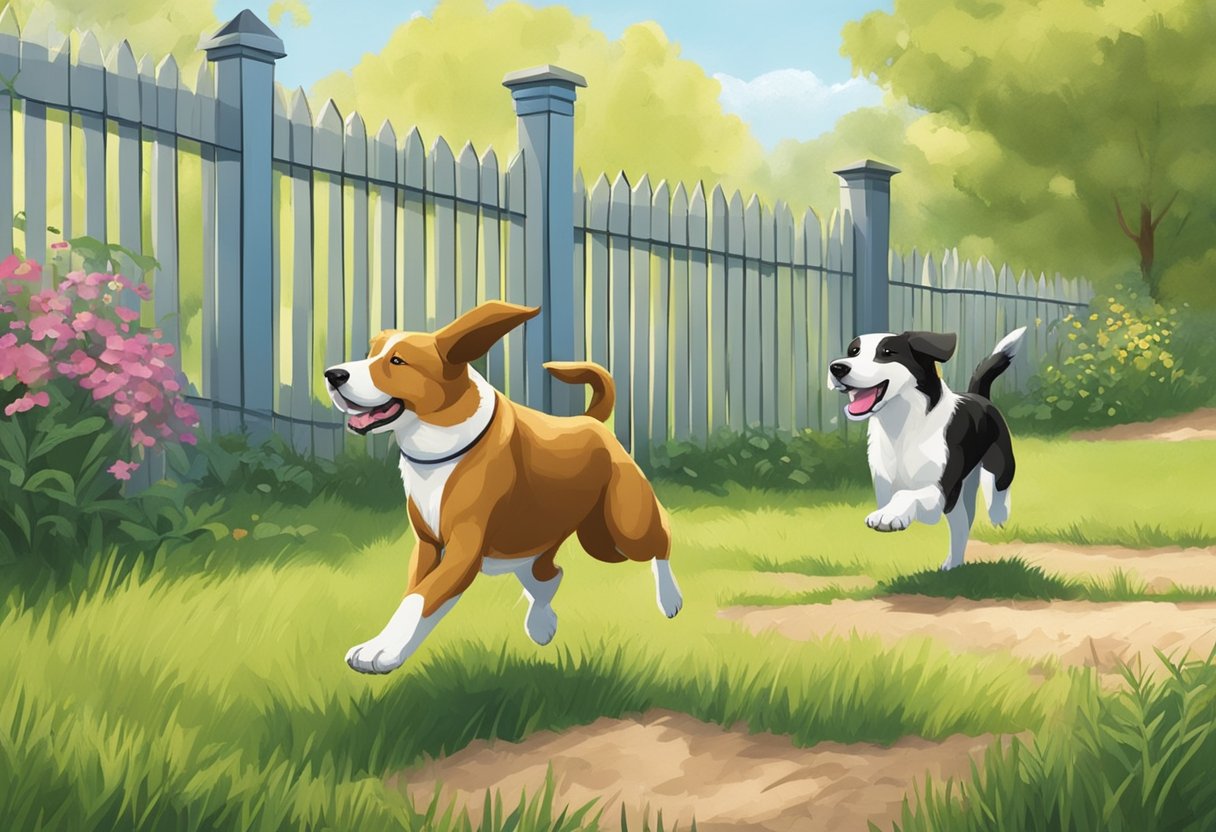
When planting new grass seed, it’s imperative for the successful establishment of a lawn that pets, particularly dogs, are kept off the seeded areas. A key concern is ensuring that seed has sufficient time to germinate undisturbed and develop deep roots.
The general timeframe recommended to keep dogs away from new grass seed is about three to four weeks. For grass types such as Perennial Ryegrass or Kentucky Bluegrass, this period allows the seeds to germinate and anchor themselves. In the case of warm-season grasses like Zoysia or Bermuda Grass, which may require slightly different care due to their tolerance of sun and heat, the timeline may vary slightly, but the safe duration generally remains the same.
During this initial growth phase, grass seeds and young shoots are delicate and can easily be damaged by dog activity. Here are steps to protect the new grass seed:
- Fence off the area: Create a physical barrier to prevent dogs from accessing the seeded zones.
- Create a temporary pathway: If necessary, build a walkway to redirect pet traffic.
- Maintenance: Monitor the area daily, watching for signs of new growth, which indicates that roots are forming, and grass is establishing.
It’s important not to mow the new grass until it’s reached ideal mowing height, which typically means waiting until it is at least three inches tall. Mowing too soon can pull up fragile new grass shoots.
Lastly, consider the climate; grass seeds established in cooler conditions might require a bit more time due to slower growth rates. In contrast, those in direct sun or warm climates may germinate and root faster. Regular maintenance and assessment during the establishment period help ensure a healthy and resilient lawn.
Health Risks Associated with Grass Seeds
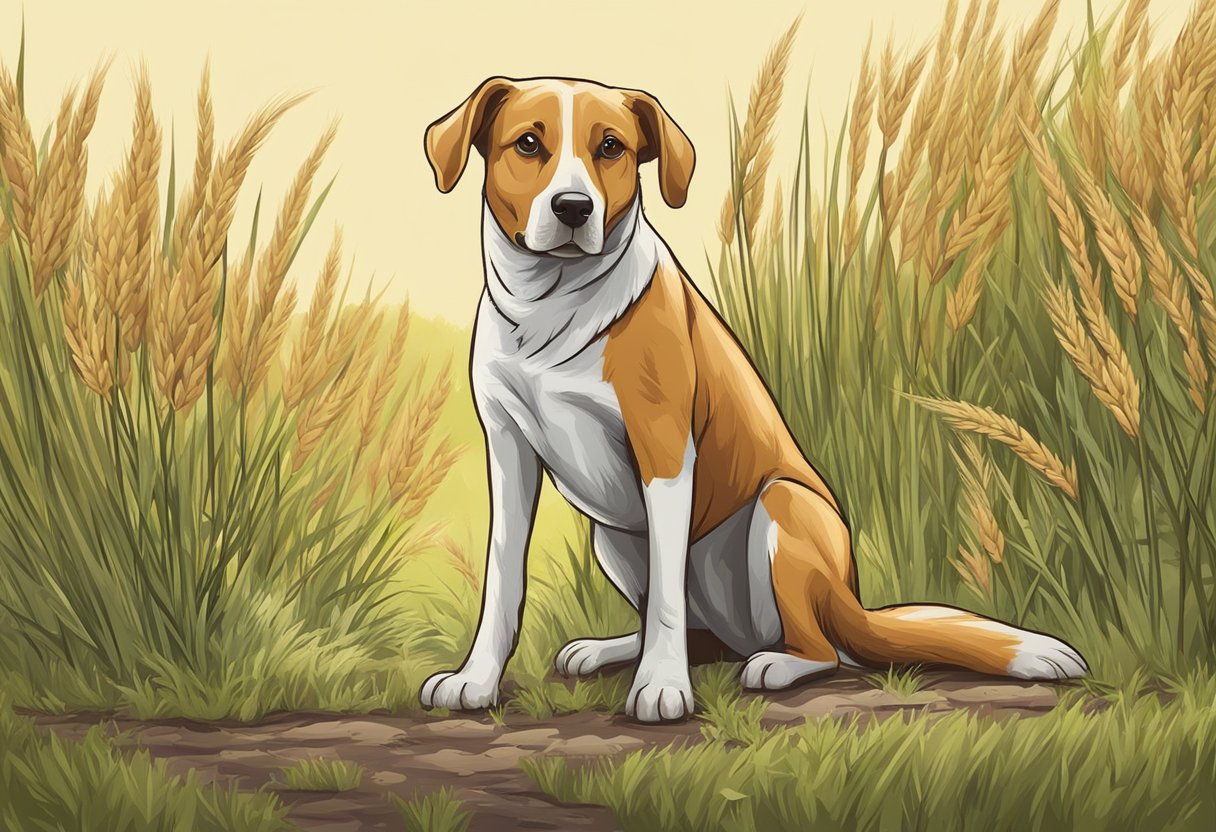
Grass seeds can pose several health risks to dogs. When dogs roam through areas with long grass, they are at risk of coming into contact with grass seeds that can become easily lodged in their fur and penetrate their skin. Grass seed wounds can occur when the sharp ends of the seeds burrow into a dog’s skin, often becoming embedded in sensitive areas such as the ears, eyes, paws, and nose.
Irritation is a common initial symptom, leading to more severe issues if the seeds are not promptly removed. Affected dogs may show signs of discomfort through persistent licking, grooming, or limping due to grass seeds embedded in their feet. Owners may also notice redness and swelling in the impacted area.
In the ears and eyes, grass seeds can cause intense irritation and potentially lead to infections. A dog’s natural inclination to scratch or shake their head to relieve discomfort can further exacerbate the problem. If seeds invade a dog’s paws or skin, they can cause localized infections or develop into abscesses if not dealt with in a timely manner.
Treatment typically involves the removal of the grass seed by a veterinarian, which may also include prescribing antibiotics to treat any resultant infection. Preventative measures, such as regular grooming and avoiding exposure to long grass during peak growing seasons, can help mitigate these risks.
Owners should remain vigilant for symptoms and seek veterinary advice if they suspect their dog has been affected by grass seeds.
Signs of Grass Seed Related Injuries in Dogs
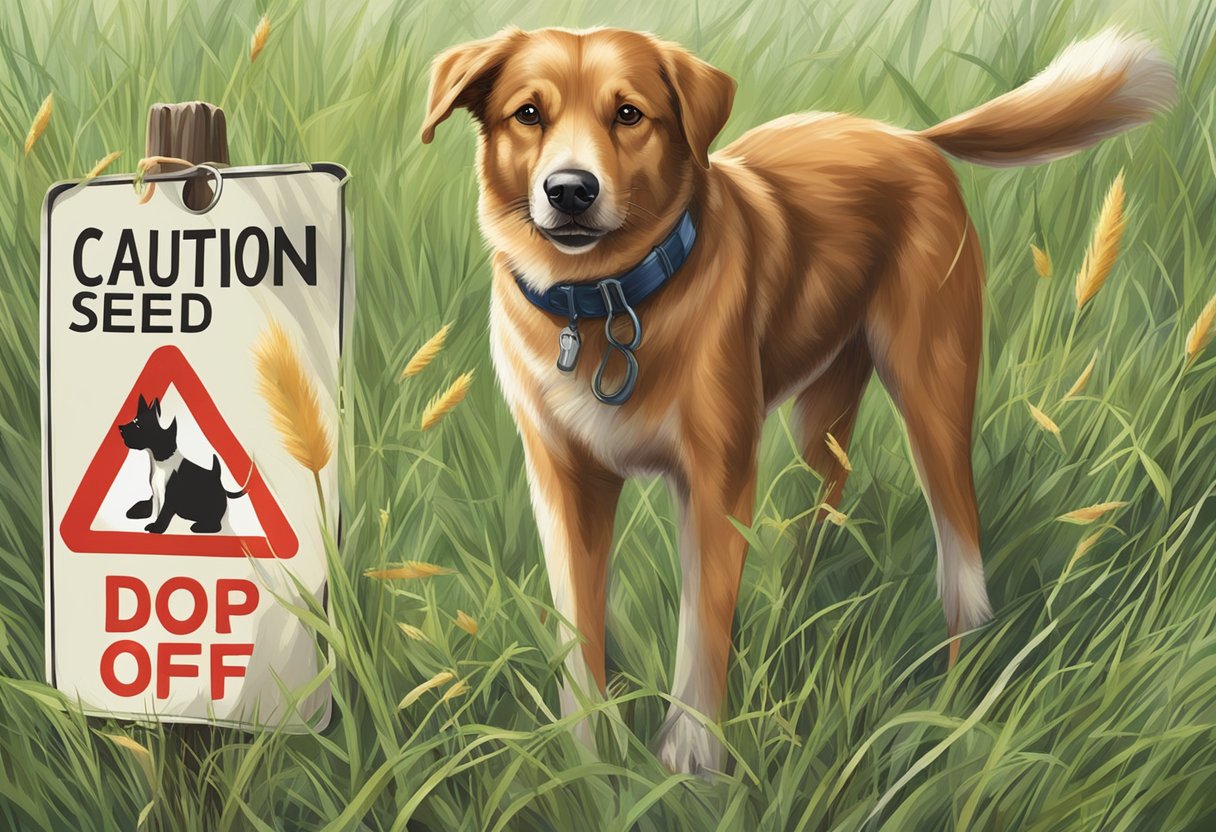
Identifying signs of injuries caused by grass seeds is crucial for dog owners, especially during the summer months when these seeds flourish in long grass. Different areas of a dog’s body, like the ears, eyes, paws, and fur, can be affected. Spaniels, with their long ears and hair, including the Springer Spaniel, are particularly susceptible to these issues.
When a grass seed burrows into a dog’s skin or gets lodged in their fur, the first indication is usually a discomfort, as seen by the dog excessively licking or nibbling at the area. This could lead to redness, swelling, or even an abscess due to infection, and in severe cases, it might necessitate removal with tweezers or other specialist veterinary tools.
- Ears: Dogs will often shake their head vigorously or paw at their ear. There might be a visible discharge or foul smell if an infection is present.
- Eyes: Keep an eye out for excessive tearing, squinting, or redness which could signal that a grass seed has invaded the eye area.
- Paws: Grass seeds can easily become embedded between the pads, leading to swelling or an apparent limping. Dogs might persistently lick their feet, and you might notice small bumps or drainage.
- Nose: Frequent, violent sneezing may occur if grass seeds are caught in the nostrils.
Prevention is essential. Make a routine to check the prone areas of your pups after walks, especially if they have ventured through long grass. Keeping the fur around the paws and ears trimmed can reduce the risk of grass seed injuries. If signs of injury are present, seeking prompt veterinary care can prevent further complications such as deep tissue infections.
First Aid and Treatment for Grass Seed Injuries
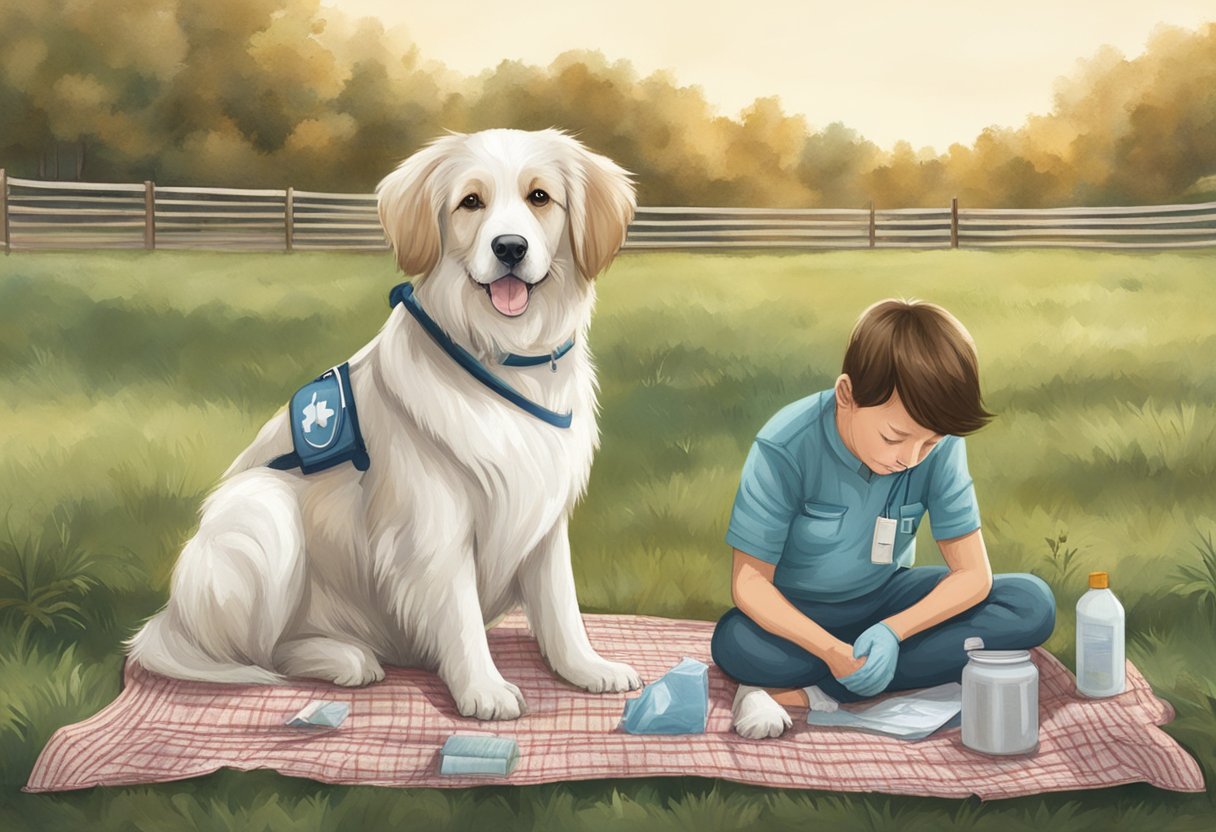
Grass seeds can cause significant discomfort and injury to dogs, necessitating prompt attention. When a dog presents symptoms such as swelling, redness, or irritation, especially around the paws, toes, and armpits, it’s crucial to check for grass seed wounds.
Initial Steps for Treatment:
- Gently inspect the affected area.
- If visible, try to remove the grass seed with tweezers.
- Clean the area with mild antiseptic.
For seeds that have penetrated the skin, causing an abscess or pus, consult a vet for proper treatment. In some cases, an X-ray may be necessary to locate the seed.
Treatments at a Veterinary Clinic Might Include:
- Surgical removal of the grass seed.
- Antibiotics to combat infection.
- Pain relief medications to alleviate discomfort.
After care following veterinary treatment is crucial. Keep the dog’s environment clean to avoid re-infection and monitor the healing process closely.
Preventive Measures:
- Keep the dog’s fur trimmed, especially around paw pads.
- Regular checks after walks in grassy areas.
Remember, inflammation or infection can worsen quickly. Early detection and immediate removal can prevent further complications such as the formation of more serious abscesses or spread of infection.
Preventing Grass Seed Injuries and Lawn Damage
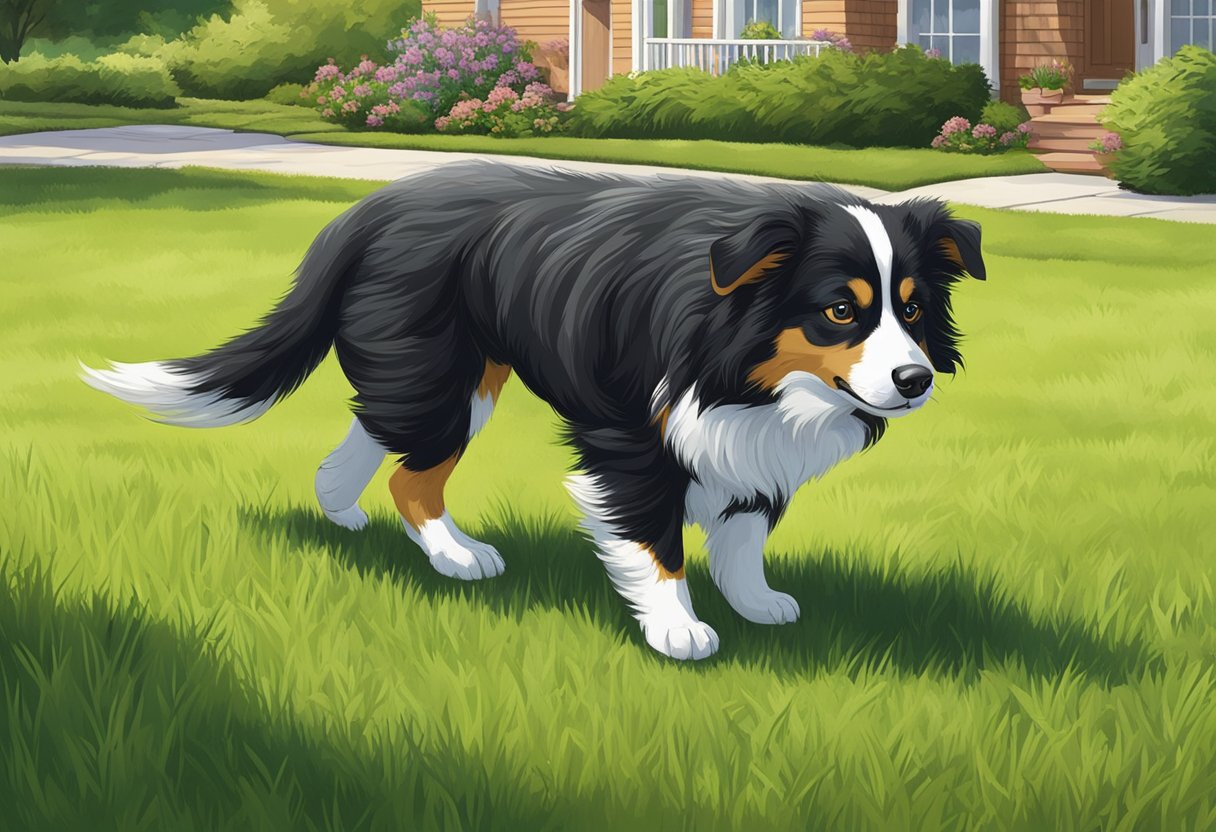
When sowing new grass seed, pet owners must take certain precautions to prevent injuries to their dogs and protect the delicate seeds from damage. Keeping dogs off the newly seeded lawn is crucial. Seeds need time without disturbance to properly germinate and grow.
- Grooming: Regular grooming of your pet reduces the risk of seeds clinging to the fur and causing redness or discomfort in the paws or skin.
- Fence: Erect a temporary barrier around seeded areas to prevent dogs from digging or urinating on fresh seeds, which can delay or prevent growth.
For lawn care:
- Fertilizers: Choose pet-friendly products to reduce health risks associated with dogs ingesting chemicals.
- Lawn Health: Select tough varieties of grass that can withstand the rough play of a dog post-establishment.
Alternative activities:
- Relocate playtime to a local dog park or another secure area in your backyard not affected by seeding.
- Schedule more walks or indoor play to keep pets entertained while the lawn establishes.
By incorporating these preventative steps, one ensures both the safety of their furry companions and the successful growth of a lush lawn.
For information on how long to keep dogs off grass seed, consider learning from Yard and Garden Guru on keeping dogs off the lawn after seeding, or refer to Edge Your Lawn for advice regarding the duration post overseeding.
Choosing Dog-Friendly Grass Varieties

When selecting grass seed for a lawn that will accommodate dogs, the resilience of the grass is crucial. Certain grass seed varieties are more robust and better suited for the wear and tear caused by canine paws. Here are some grass types that typically have deep roots and long blades, ensuring they can withstand active dogs.
- Perennial Ryegrass: This grass is known for quick germination and establishing a strong root system. Its ability to recover from wear makes it a top choice for dog owners.
- Kentucky Bluegrass: This variety is praised for its dense growth and self-repairing nature, which helps it bounce back from pet activity.
- Tall Fescue: Its deep roots make tall fescue durable and able to handle high traffic, even from the busiest of paws.
- Bermuda: This is a warm-season grass that handles heat and repeated use well, making it ideal for warmer climates.
When considering grass types, think about your local climate and the needs of your lawn. If you’re living in a warmer zone, Zoysia and Bahia grass are excellent options due to their tolerance to heat and drought conditions.
It’s also helpful to apply Scott’s Natural Lawn Food to support robust growth, ensuring that the grass remains nutritious for the lawn and indirectly benefiting your dog’s lungs as they breathe in the fresh air during play outside.
Remember to cordon off newly seeded areas, possibly by using a temporary fence, to prevent dogs from disrupting the growth process. Until the lawn is established, consider taking your dog to a local dog park to protect your budding grass.
Frequently Asked Questions
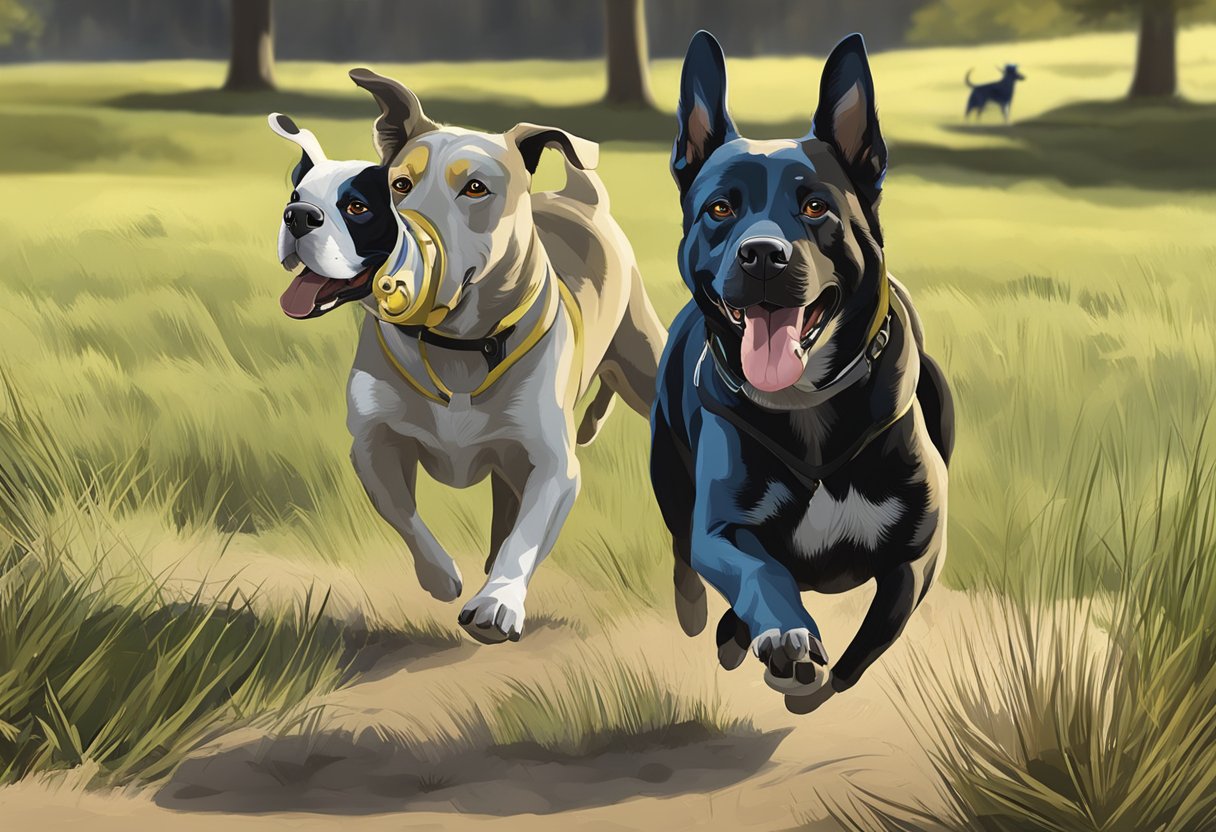
When planting grass seed in an environment shared by dogs, it’s essential to address common concerns to ensure a healthy lawn and a safe space for pets. This section explores practical solutions and timings for yard maintenance activities that are crucial for achieving these goals.
What are pet-friendly options for planting grass seed in a yard with dogs?
Pet-friendly grass options include hardier varieties that can withstand traffic from dogs, such as perennial ryegrass, tall fescue, and Kentucky bluegrass. These types of grass can better resist the wear and tear from a dog’s activities in the yard.
What measures can be taken to protect newly planted grass seed from dogs?
One can protect new grass by using temporary fences or barriers to keep dogs away, applying mulch or straw to shield the seeds, and utilizing repellents to discourage them from approaching the seeded areas. Such measures help give the new grass a chance to establish before being exposed to canine activities.
How soon after planting grass seed is it safe for dogs to walk on the lawn?
Dogs should be kept off new grass seed for at least three weeks after planting to allow the seeds to germinate and establish roots, minimizing the risk of damage from their paws and activity.
What is the recommended waiting period before mowing newly seeded grass in a yard with dogs?
Once grass has reached about 3 inches in height, it’s usually safe to mow. This typically takes about 3-4 weeks after seeding, depending on the grass variety and growth conditions. Mowing too soon can disturb the young roots, so patience is key.
How do you overseed a lawn while ensuring it’s safe and doesn’t disrupt your dog’s activities?
Overseeding should be done during a dog’s less active hours, and temporary barriers may be used to section off areas for overseeding. Ensuring that dogs have an alternative area to play until the new grass is established will keep both the lawn and the dog’s routine minimally disrupted.
After fertilizing a lawn with products like Scotts, how long should dogs stay off the grass?
For fertilizers such as those offered by Scotts, it is crucial to wait until the product is fully watered in and the lawn is dry before letting dogs back onto the grass. The waiting period may vary, but usually, 48 hours is recommended to ensure safety for the pets.
